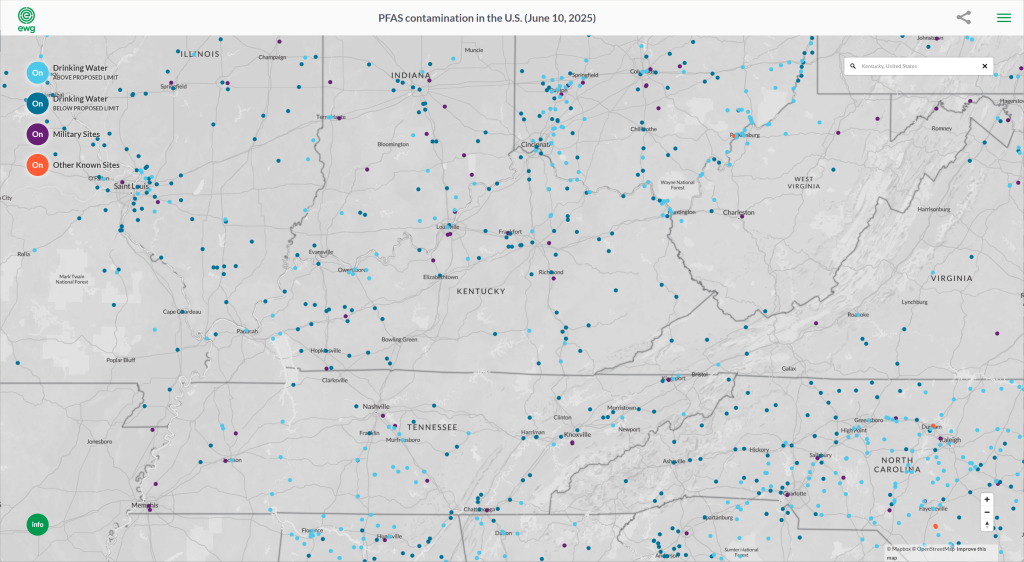- Home
- Personal Injury
- PFAS Lawsuit
- PFAS Contamination Map
- PFAS in Louisiana
PFAS in Louisiana
- Last updated: July 16, 2025
-
Contributor: nicky

I have spent considerable time reviewing the latest data on PFAS Kentucky concerns, including new federal regulations aimed at curbing contamination in public drinking water. In 2024, the U.S. Environmental Protection Agency (EPA) finalized enforceable standards for six per- and polyfluoroalkyl substances (PFAS). Among these was a maximum contaminant level (MCL) of 4 parts per trillion (ppt) for two of the most common PFAS compounds, PFOA and PFOS. Kentucky’s water utilities have until April 26, 2027, to comply, according to the finalized rule.
PFAS, sometimes called “forever chemicals,” are extremely persistent in the environment and have been detected in soil, fish, and drinking water across the state. State testing shows detectable PFAS in 44% of Kentucky’s water treatment plants. Although fewer than 10% of these plants appear to exceed the new federal limit, even lower-level contamination can raise health concerns. My aim here is to share, in plain terms, how Kentucky’s water systems are addressing these challenges, where contamination is most serious, and whether you may be eligible for legal recourse if PFAS has impacted you or your property.
What are PFAS and why are they dangerous?
PFAS refers to a broad group of chemicals prized for their water-, heat-, and oil-resistant properties. Since the mid-20th century, numerous industries have relied on PFAS for everything from non-stick cookware to stain-resistant fabrics and firefighting foam. The same chemical characteristics that make PFAS so versatile also cause them to degrade slowly in the environment. As a result, PFAS can linger in groundwater, rivers, and agricultural soils.
Exposure to PFAS is a concern because studies continue to connect these chemicals to health risks. Research by state and federal agencies indicates that chronic exposure may be associated with kidney cancer, testicular cancer, thyroid disease, elevated cholesterol, and possible liver damage. The Centers for Disease Control and Prevention (CDC) updated its guidance in January 2024, highlighting links between PFAS exposure and an increased risk of kidney cancer. Many states, including Kentucky, are working to address potential hazards tied to this evolving science.
Where are PFAS found in Kentucky?
PFAS contamination in Kentucky is not confined to a single corner of the state. The Kentucky Energy and Environment Cabinet has detected these compounds in water, fish, and some soil samples. According to official figures, 83 out of 194 water treatment plants had measurable PFAS at some point in the last five years. Public health officials say that PFAS can enter water sources from industrial run-off, landfills, firefighting activities, and manufacturing plants that use fluorinated compounds.
In some parts of Kentucky, researchers identified PFAS in local fish. The state tested 98 fish samples from various lakes and rivers, and all 98 had detectable PFAS levels. Focus has also turned to farmland, where PFAS could reach agricultural soil via biosolids, irrigation, or runoff. Although serious contamination hotspots are limited, the presence of PFAS in these diverse ecosystems continues to spark questions about broader environmental and human-health impacts.
PFAS in Kentucky’s drinking water
When I speak with residents across Kentucky about PFAS, drinking water is often their main concern. Under the new EPA standards, public utilities must keep PFOA and PFOS concentrations below 4 ppt. These rules mark a significant shift in federal regulation. The Kentucky Division of Water (DOW) has been proactive in mapping where PFAS occurs and helping communities prepare. Officials caution that while most utilities currently fall within allowable limits, many will need to improve treatment processes before 2027 to ensure compliance.
Impacted cities and water supplies
Some of the most notable PFAS detections happened in small to mid-sized communities. The city of South Shore in Greenup County recorded the highest PFAS levels among the systems tested. In response, it secured over USD 8 million to build a new water line connecting with Portsmouth, Ohio, across the Ohio River, thereby bypassing the PFAS-contaminated supply.
Marshall County also faced contamination in at least one of its groundwater wells. Approximately 650 customers lost service from a particular treatment plant after state tests discovered PFAS beyond proposed federal limits. Meanwhile, Lewisport in Hancock County initiated a pilot study using a reverse-osmosis system to remove PFAS and is now considering a new water treatment plant, which might cost USD 15 million. Each affected city is exploring unique solutions, ranging from advanced filtration to entirely new water sources.
Kentucky Department for Environmental Protection (KDEP) testing
Over the last five years, the Kentucky Department for Environmental Protection (KDEP) tested 91% of the state’s water treatment plants for forever chemicals. Of the facilities tested, 44% showed detectable PFAS, though fewer than 10% of more than 400 utilities reportedly exceed the new federal threshold (John Mura, spokesperson for the Kentucky Energy and Environment Cabinet, said). KDEP is currently focusing on those plants above the 4 ppt level to ensure short-term fixes and long-term compliance. Utilities that fail to meet the limit could face enforcement actions, potentially including fines and mandates to upgrade longstanding infrastructure.
Sources of contamination: Industry, firefighting foam, and landfills
Although PFAS in Kentucky partly originates from industrial sites, other sources also contribute to the problem. Military bases, airports, and firefighting training facilities frequently use high-volume firefighting foam containing PFAS. In addition, landfill leachate can transport PFAS into nearby waterways or groundwater. Various manufacturing businesses have historically relied on PFAS for products like Teflon coatings, water-resistant apparel, and stain-proof carpeting. With regulations tightening, identifying all relevant emission points has become a priority for local authorities, especially as the 2027 compliance deadline draws nearer.
PFAS in Kentucky’s soil and agriculture
Agricultural contamination by PFAS can occur when soil interacts with industrial or landfill runoff, or when biosolids used as fertilizer contain trace amounts of PFAS. Over time, crops and livestock may become exposed, creating potential transfer of these substances into the food supply. Current data indicates that PFAS is more concentrated in water sources than in crops themselves, but further research is ongoing. Given Kentucky’s substantial farming sector, officials worry that any long-term soil contamination could influence yields and potentially place small farms at risk.
Fish samples from local rivers and lakes have shown elevated PFAS levels. Given the interconnected nature of soil, water, and the food chain, agencies continue to track contamination beyond municipal water sites. Although no widespread advisories on produce have been issued, the Kentucky Division of Water and the Kentucky Department of Agriculture continue investigating whether PFAS accumulates in certain crops or farmland regions. Early detection of PFAS in soil could help safeguard Kentucky’s agricultural economy and protect public health.
Health effects of PFAS exposure
I have reviewed many of the state and federal reports on PFAS, which point to consistent themes in terms of health outcomes. High or long-term exposure to these chemicals can cause:
- Kidney damage and higher risk of renal cell carcinoma
- Potential testicular cancer, especially in areas with heavy firefighting foam usage
- Possible thyroid dysfunctions, including hypo- and hyperthyroidism
- Cholesterol increases affecting cardiovascular health
- Potential damage to liver tissue
Researchers also emphasize that exposure risk varies depending on individual factors. Vulnerable groups, including pregnant women and immunocompromised individuals, may be more susceptible. Federal agencies like the CDC are continuing to investigate the exact nature and extent of health effects, while the EPA is fine-tuning safe exposure limits for additional PFAS.
PFAS-linked diseases in Kentucky
Kentucky has identified several PFAS-linked diseases through public health data and environmental monitoring. While other states have likewise documented PFAS-related problems, Kentucky-specific findings provide more localized context. I want to highlight four primary health effects: kidney cancer, testicular cancer, thyroid disease, and the potential for liver damage or higher cholesterol.
Kidney cancer
Kidney cancer is one of the most frequently cited risks in PFAS-related discussions. Researchers have drawn a strong connection between perfluorooctanoic acid (PFOA) and renal cell carcinoma. In 2021, Kentucky recorded an estimated 1,200 new cases of kidney cancer, resulting in about 350 deaths. Some experts point out that PFOA might exacerbate pre-existing kidney issues, putting those with a family history at greater risk. According to a January 2024 CDC update, the exact biological mechanism remains under investigation, but current evidence underscores a need for continued vigilance and broader medical screening among exposed populations.
Testicular cancer
Some Kentucky communities near military bases like Fort Knox and the Blue Grass Army Depot have raised concerns about elevated testicular cancer rates. Firefighting foam extensively used on these bases often contained PFAS compounds. Though available statistics do not confirm a direct nationwide spike in testicular cancer, localized environmental investigations suggest potential correlations. Residents worried about contamination in those areas are pressing for more comprehensive epidemiological studies to clarify whether PFAS from foam usage contributes to higher incidence rates.
Thyroid disease
PFAS may alter normal thyroid function, leading to various disorders, including hyperthyroidism, hypothyroidism, thyroiditis, Graves’ disease, and Hashimoto’s disease. In Kentucky, patients with suspected PFAS-related thyroid conditions often report fatigue, marked changes in weight, and other metabolic irregularities. While specific Kentucky-wide thyroid illness data remain limited for now, medical experts confirm that endocrine disruption from PFAS is plausible. The state’s public health agencies encourage consistent monitoring and thyroid-function testing if someone has documented PFAS exposure.
Liver damage and cholesterol changes
Studies have also identified potential associations between PFAS and abnormal liver enzymes or changes in cholesterol profiles. PFAS could weaken the liver’s natural ability to break down toxins, leading to gradual damage over time. Residents in communities with documented PFAS contamination sometimes report elevated cholesterol levels during their routine checkups. Currently, these findings align with national data indicating that PFAS can affect lipid metabolism, although more population-specific studies are needed within Kentucky to confirm the extent of this risk.
How Kentucky is responding to the PFAS crisis
Kentucky’s response to PFAS is multifaceted, covering stricter testing, risk communication, and efforts to secure funding for remediation. I have followed the Kentucky Department for Environmental Protection and the Kentucky Division of Water as they coordinate with the EPA and local utilities. Early action is essential, especially with the 2027 compliance deadline on the horizon. Officials note that prompt infrastructure upgrades and public education programs may avert costlier interventions in the future.
KDEP actions and statewide sampling
KDEP leads statewide PFAS sampling across municipal water sources. Its goal is to pinpoint facilities that exceed the newly established limits. Once identified, these utilities are required to propose and implement a remediation strategy. In communities with only modest PFAS detections, KDEP is encouraging advanced treatment pilot projects, such as granular activated carbon or reverse-osmosis systems. Early intervention, officials say, helps prevent unexpected expenses later on.
Public health advisories and risk communications
State agencies have increased public outreach through community meetings, online portals, and local press events. Kentucky health officials, in partnership with the Division of Water, issue advisories whenever PFAS levels surpass thresholds that regulators consider safe. Many counties now distribute fact sheets explaining PFAS science and clarifying how to reduce personal exposure. Although these advisories are not legally binding, they serve as early-warning systems, particularly for vulnerable populations.
Federal support and EPA collaboration
The Biden administration announced USD 2 billion in grant funding for rural communities battling PFAS contamination, acknowledging that smaller towns often lack the resources to install expensive filtration systems. Several Kentucky municipalities have already applied for a portion of these funds, and further support may come from the federal Drinking Water State Revolving Fund. State and federal authorities are keeping a close watch on new data to ensure local responses align with updated EPA guidelines. However, many experts note that the federal support may fall short of fully resolving infrastructure shortfalls in large or severely contaminated areas.
Can you test your water or soil for PFAS in Kentucky?
If you suspect PFAS contamination, your first step is to contact your local water utility and request the latest test results. You can also seek private testing through accredited laboratories that specialize in PFAS analysis. Some communities partner with state agencies under voluntary sampling programs for well-water users, especially in areas near industrial sites, landfills, or firefighting facilities.
While test kits are available online, they often lack the precision needed to confirm low-level contaminations that are still relevant under the new 4 ppt limit. If you want reliable data, it is best to use a lab certified for PFAS testing. By identifying any existing contamination early, you can work with water-treatment professionals or environmental consultants to determine whether additional filtration options, like reverse osmosis or granular activated carbon, may be necessary.
Do you qualify for a PFAS lawsuit in Kentucky?
If PFAS exposure has harmed you or your property, you may have grounds to pursue legal action. Certain lawsuits allege that manufacturers or industries negligently allowed PFAS to leach into municipal water systems. In Kentucky, lawsuits also arise from private wells or farmland contamination. To evaluate your legal options:
- Determine whether PFAS levels at your residence, workplace, or farm exceed federal or state guidelines.
- Gather documentation of water tests, soil analyses, or expert opinions, if applicable.
- Assess any health conditions that might be tied to PFAS exposure.
If these factors apply to you, it could strengthen your case for compensation. I encourage you to read more about your potential legal options at Legal Claim Assistant’s PFAS Lawsuit page. You may also learn about water contamination legal avenues at the Assistant’s Water Contamination Lawsuit resource or the details surrounding the DuPont lawsuit.
Why choose Legal Claim Assistant
I understand that navigating PFAS complexities can be daunting, especially when initiating a legal claim. Legal Claim Assistant focuses on connecting victims to experienced lawyers equipped to handle PFAS lawsuits. Their platform offers:
- A free, straightforward case review
- Guidance from professionals who understand federal and state PFAS regulations
- Resources to help document contamination and potential health-related claims
When you work with Legal Claim Assistant, you gain a partner that assists you in gathering evidence, consulting scientific experts, and communicating with local officials. By combining legal knowledge with environmental expertise, the service can help you file a claim that might ease the financial burdens of cleanup, medical monitoring, and property-value loss.
Frequently asked questions (FAQ)
Below, I have answered some of the most common PFAS questions in Kentucky. If you still need more details, I encourage you to follow up with local agencies or consult an attorney for legal advice.
PFAS contamination has been documented in several water treatment plants, groundwater supplies, fish samples, and certain industrial sites. Communities such as South Shore, Marshall County, and Lewisport have reported levels above proposed federal standards in recent years.
Yes. You can ask your local utility for recent PFAS test results or hire an accredited laboratory to test a private well. Standard home test kits do exist, but laboratory testing is recommended for accurate measurement.
Kentucky’s Department for Environmental Protection and Division of Water conduct routine sampling to locate and address PFAS sources. They issue public health advisories when levels exceed certain thresholds and encourage early coordination with water-treatment and funding programs.
PFAS has been detected in some soil samples and waterways in agricultural regions. So far, no widespread contamination has been reported in produce. However, investigators remain cautious and advise farmers to remain aware of the potential for biosolid or industrial runoff.
Researchers have associated PFAS exposure with kidney cancer, testicular cancer, thyroid disease, potential cholesterol elevation, and liver damage. The severity of health impacts varies depending on individual factors such as age, duration of exposure, and overall health profile.
You may be eligible if you can show significant PFAS presence affecting your home, farm, or health. Legal claims often focus on negligence by manufacturers, industrial facilities, or other responsible parties. Contacting a service like Legal Claim Assistant can help you explore your options.
If you would like to see the PFAS challenges faced in other states, you can read more in articles like PFAS in Minnesota or PFAS in Georgia. These resources compare testing procedures and remediation efforts being implemented elsewhere.
Overview PFAS contamination in the USA
Here you van find the PFAS watercontamination map of the United States. Find, state by state, where water contamination has occurred due to PFAS exposure.
- PFAS in Alabama
- PFAS in Alaska
- PFAS in Arizona
- PFAS in Arkansas
- PFAS in California
- PFAS in Colorado
- PFAS in Connecticut
- PFAS in Delaware
- PFAS in Florida
- PFAS in Georgia
- PFAS in Hawaii
- PFAS in Idaho
- PFAS in Illinois
- PFAS in Indiana
- PFAS in Iowa
- PFAS in Kansas
- PFAS in Kentucky
- PFAS in Louisiana
- PFAS in Maine
- PFAS in Maryland
- PFAS in Massachusetts
- PFAS in Michigan
- PFAS in Minnesota
- PFAS in Mississippi
- PFAS in Missouri
- PFAS in Montana
- PFAS in Nebraska
- PFAS in Nevada
- PFAS in New Hampshire
- PFAS in New Jersey
- PFAS in New Mexico
- PFAS in New York
- PFAS in North Carolina
- PFAS in North Dakota
- PFAS in Ohio
- PFAS in Oklahoma
- PFAS in Oregon
- PFAS in Pennsylvania
- PFAS in Rhode Island
- PFAS in South Carolina
- PFAS in South Dakota
- PFAS in Tennessee
- PFAS in Texas
- PFAS in Utah
- PFAS in Vermont
- PFAS in Virginia
- PFAS in Washington
- PFAS in West Virginia
- PFAS in Wisconsin
- PFAS in Wyoming
Related Article

What Philips CPAP Machines Are Recalled and Why

